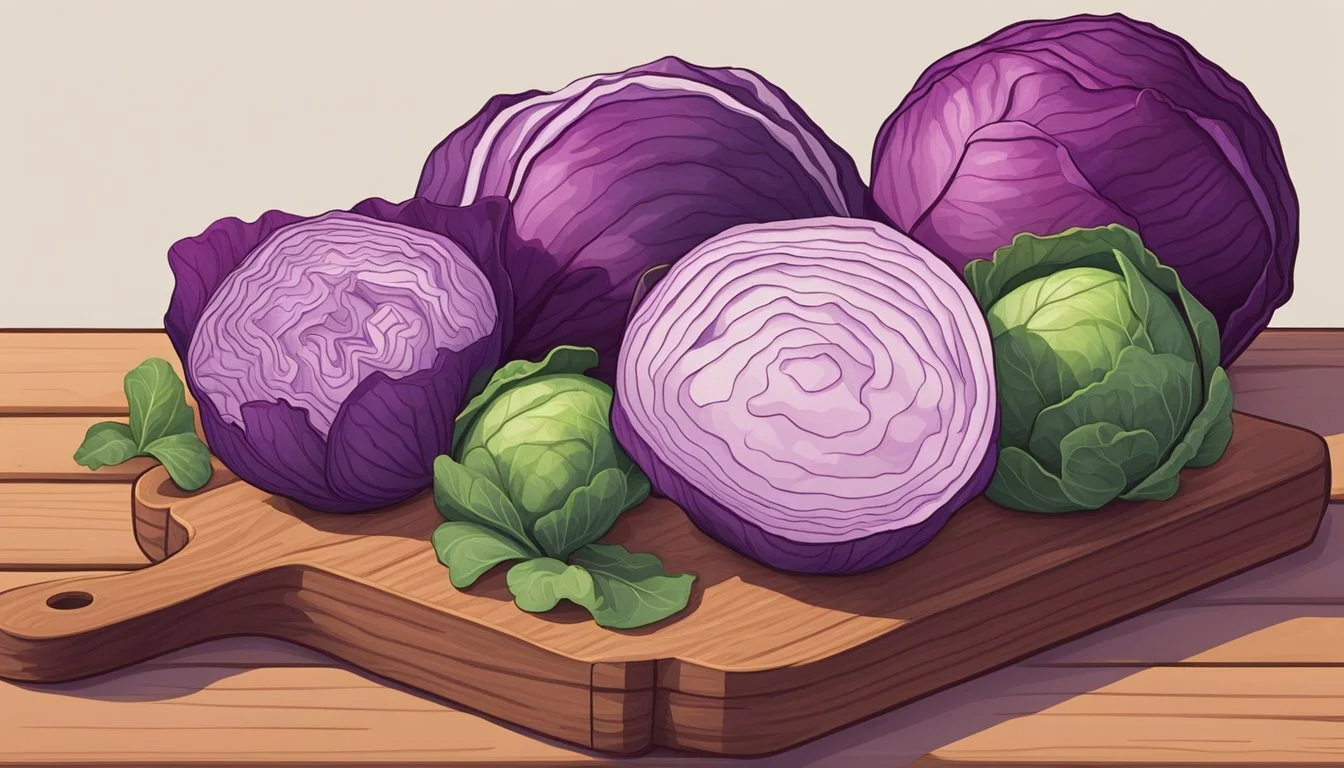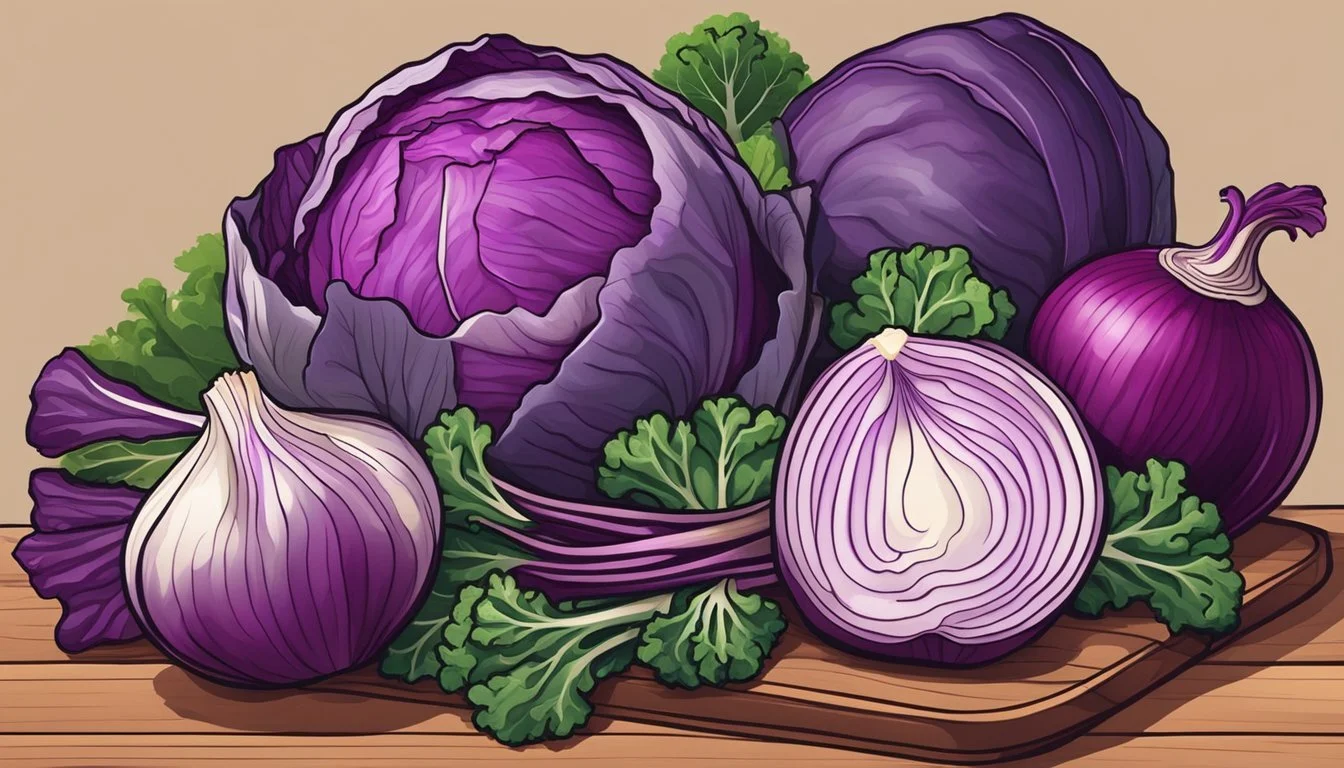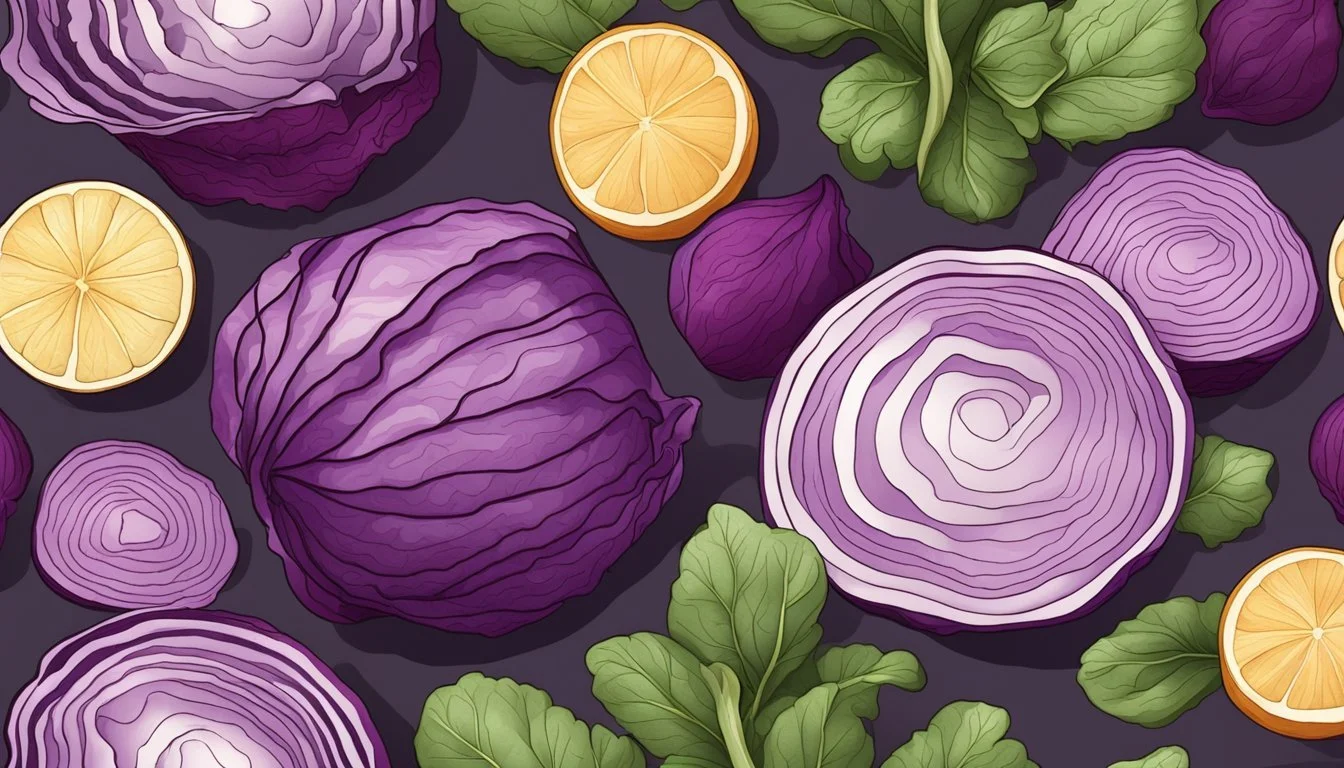Red Cabbage Substitutes
Top Alternatives for Any Recipe
Finding yourself without red cabbage for your recipe can be frustrating. Luckily, there are numerous substitutes that not only match its vibrant color but also provide similar texture and nutritional benefits. Green cabbage is a fantastic substitute that brings a slightly sweet crunch to your dishes, making it the closest match to red cabbage. It fits effortlessly into recipes calling for red cabbage and is easy to find in stores.
For those seeking a more nutritious option, kale offers a robust, slightly bitter flavor that softens when cooked. It works exceptionally well in cooked dishes, providing a hearty texture and high nutritional value. Celery, though not as commonly discussed, comes in a red variety and can be a surprising alternative, adding a different yet complementary crunch to salads and other raw applications.
These substitutes ensure that your meals remain delicious and visually appealing, even without red cabbage. Their versatile use in many recipes guarantees that you won’t miss out on creativity in the kitchen.
Understanding Red Cabbage
Red cabbage is a versatile vegetable noted for its vibrant color and firm texture. It offers a range of nutritional benefits and is widely used in various culinary applications, from salads to soups.
Nutritional Profile
Red cabbage is rich in essential nutrients. It is packed with vitamins such as A, C, K, and folate. This vegetable also provides significant amounts of calcium, potassium, and manganese.
An important feature of red cabbage is its high fiber content, which aids in digestion. Additionally, it contains antioxidants like quercetin, which help combat oxidative stress in the body. These attributes make red cabbage a nutritional powerhouse and an important addition to a balanced diet.
Culinary Uses
Red cabbage is celebrated for its role in various dishes. Its firm texture and slightly peppery taste make it ideal for raw applications such as salads and slaws. It maintains its crunchiness, adding a pleasant bite to these dishes.
In cooked dishes, red cabbage softens and develops a sweet flavor. It works well in soups, stews, and even stuffing recipes. In Chinese cuisine, it's often used in stir-fries, adding both color and flavor. Its versatility makes it a staple in multiple cooking traditions worldwide.
Health Benefits
Red cabbage offers numerous health benefits. Its high fiber content supports healthy digestion and can help prevent constipation. The antioxidants found in red cabbage can reduce inflammation and may lower the risk of chronic diseases.
The vegetable's role in heart health is particularly notable. Nutrients like potassium help regulate blood pressure, while the vitamins and antioxidants contribute to overall heart function. Moreover, the presence of compounds like quercetin offers additional protective effects against cardiovascular diseases. This makes red cabbage an excellent choice for those looking to improve their health.
Popular Red Cabbage Substitutes
When red cabbage is unavailable, several other vegetables make excellent substitutes. Each alternative has unique characteristics, allowing for versatile use in various dishes.
Green Cabbage
Green cabbage is a primary substitute for red cabbage, sharing many similarities. It belongs to the same Brassica oleracea family and offers a nearly identical texture.
Its flavor is mild and slightly sweet, making it suitable for a wide range of recipes, from salads to stews. Unlike red cabbage, green cabbage has a lighter color, which might change the visual appeal of the dish but not the taste. It is widely available and can be found in most grocery stores throughout the year.
Savoy Cabbage
Savoy cabbage is another notable replacement for red cabbage. It has a more delicate and crinkled leaf texture, which is softer than green cabbage.
This variety is also high in fiber and contains numerous vitamins, making it a healthy option. Savoy cabbage's slightly sweet and earthy flavor pairs well with numerous dishes, including soups, sautés, and salads. Its distinct appearance can add visual interest to a meal while maintaining a similar culinary profile.
Napa Cabbage
Napa cabbage, often referred to as Chinese cabbage, is yet another member of the Brassica oleracea family. It is known for its long, light green leaves and mild taste.
Napa cabbage is an excellent substitute for red cabbage in dishes requiring a tender and subtle flavor. Its high water content allows it to cook quickly, making it suitable for stir-fries and soups. It's also an excellent choice for fresh salads, providing a crisp texture and gentle crunch.
Bok Choy
Bok choy, another type of Chinese cabbage, serves as a versatile substitute for red cabbage. It has dark green leaves and pale, crisp stalks, which offer a different texture combination.
Often used in Asian cuisines, bok choy can be stir-fried, steamed, or added to soups. Its mild, slightly peppery taste works well as a replacement in dishes where red cabbage's sharpness might be too strong. Bok choy’s high nutritional value also makes it a healthy choice in substitution.
Kale
Kale is a leafy green commonly used as a substitute for red cabbage, particularly in cooked dishes. It has a robust, slightly bitter flavor that mellows when cooked.
Rich in vitamins like A, K, and C, kale is a nutritious option. It can be used in a 1:1 ratio for cooked dishes and a 2:1 ratio for raw applications, providing flexibility in various recipes. Kale's tough texture softens with heat, making it suitable for soups, stews, and sautés.
Alternative Substitutes for Red Cabbage
When looking for alternatives to red cabbage, options like broccoli, cauliflower, Brussels sprouts, kohlrabi, and various leafy greens can be excellent substitutes. Each provides its own unique texture and flavor that can complement many recipes.
Broccoli and Cauliflower
Broccoli and cauliflower can be great replacements for red cabbage in a variety of recipes. Broccoli offers a crunchy texture and mild flavor, which works well in salads and stir-fries. Cauliflower shares a similar versatility; its neutral taste can absorb spices and sauces, making it an ideal substitute in coleslaws and casseroles. Both vegetables offer abundant nutrients, including vitamins C and K, and fiber.
Brussels Sprouts and Kohlrabi
Brussels sprouts have a compact structure and a distinctive, slightly nutty taste. They can be shredded and used in slaws or sautéed for side dishes. Kohlrabi, often described as a cross between a cabbage and a turnip, has a crisp texture and mildly sweet flavor. It can be sliced raw in salads or cooked in a variety of dishes. Both are members of the Brassica family and provide similar health benefits to red cabbage.
Leafy Greens Variety
Various leafy greens can serve as substitutes for red cabbage. Spinach and lettuce have a more delicate texture but can add freshness to salads. Swiss chard and collard greens offer a heartier leaf and more robust flavor, suitable for stews and stir-fries. These greens are rich in vitamins A, C, and K, making them nutritious alternatives. Their versatility allows them to be used raw in salads or cooked in numerous dishes, providing both flavor and health benefits.
Unique Flavor Substitutes
When seeking alternatives to red cabbage, it's essential to consider options that provide distinctive flavors and textures. Various vegetables can offer unique tastes, from bitter and peppery to mild and crunchy.
Radicchio and Endives
Radicchio and endives provide a bitter and peppery flavor that can complement a variety of dishes. Radicchio, with its vibrant red leaves and crisp texture, is often used in salads and adds a bold taste. Endives, on the other hand, have a slightly milder bitterness and are great for both raw and cooked applications.
Both vegetables can be used as substitutes for red cabbage to introduce a different, yet complementary, taste profile to your recipes. Radicchio holds up well in grilled preparations, while endives are excellent for adding crunch to salads or as a base for toppings in appetizers.
Iceberg Lettuce and Romaine
Iceberg lettuce and romaine are milder alternatives to red cabbage. Iceberg lettuce has a high-water content, making it exceptionally crispy and ideal for dishes where you want a light and refreshing crunch.
Romaine lettuce is slightly more robust than iceberg, offering a firmer texture and a subtle, sweet flavor. Both types of lettuce can be used in salads, wraps, and as a crunchy layer in sandwiches. These substitutes may not replicate the exact flavor of red cabbage, but they do provide a pleasing, crisp texture that can enhance many recipes.
Beet Greens and Beetroot
Beet greens and beetroot are excellent choices when looking to replace red cabbage with something equally unique. Beet greens offer a slightly bitter flavor with a touch of sweetness and can be used in sautéed dishes or salads. They are comparable to kale or spinach in texture and nutritional value.
Beetroot, on the other hand, has a sweet, earthy flavor and can be used in both raw and cooked forms. It provides a vibrant color similar to red cabbage and works well in salads, pickled preparations, and roasted vegetable dishes. Beet juice can also be used to add color to dishes, enhancing their visual appeal while offering a unique taste.
Non-Cabbage Vegetable Substitutes
When red cabbage isn't on hand, a variety of non-cabbage vegetables can serve as excellent substitutes. Each offers unique flavors, textures, and nutritional benefits, enriching your dishes in different ways.
Celery and Celery Root
Celery, recognizable by its crisp texture and mild flavor, is a versatile substitute. Though not as vibrant, its crunch adds a refreshing element to salads and slaws. For cooked dishes, celery can complement soups or stews, providing a slight bitter undertone that enhances savory flavors.
Celery root, also known as celeriac, has a denser texture. When cooked, it offers a slightly nutty flavor that contrasts with the earthier taste of red cabbage. Use it in mashed, roasted, or pureed forms for a creamy texture with a subtle celery essence.
Cucumber and Zucchini
Cucumbers are great for raw dishes due to their high water content and crisp texture. They bring a light, refreshing quality to salads and can be sliced, diced, or spiralized. Though lacking the robust flavor of red cabbage, cucumbers add a hydrating crunch that complements many ingredients.
Zucchini, another excellent option, can be used both raw and cooked. When raw, zucchini offers a mild, slightly sweet taste that works well in salads and slaws. When cooked, it becomes tender and takes on a richer flavor, suitable for stir-fries and casseroles. Zucchini is also a low-calorie alternative, providing a nutritious boost.
Green Beans and Choy Sum
Green beans are a suitable replacement for red cabbage, especially in cooked dishes. Their firm texture and slight sweetness make them perfect for stir-fries and soups. They also retain their shape and crispness when cooked, ensuring a pleasant bite in any recipe.
Choy sum, a leafy green with tender stalks, is a superb substitute for both raw and cooked applications. It has a slightly peppery taste and tender, succulent leaves. Choy sum is best when quickly sautéed, steamed, or added to soups, retaining its vibrant green color and crunch. Adjust seasoning to highlight its natural flavors.
Celery and celery root, cucumber and zucchini, and green beans and choy sum each offer distinct advantages. They can seamlessly integrate into various culinary preparations, enhancing your dishes with their unique textures and flavors.






